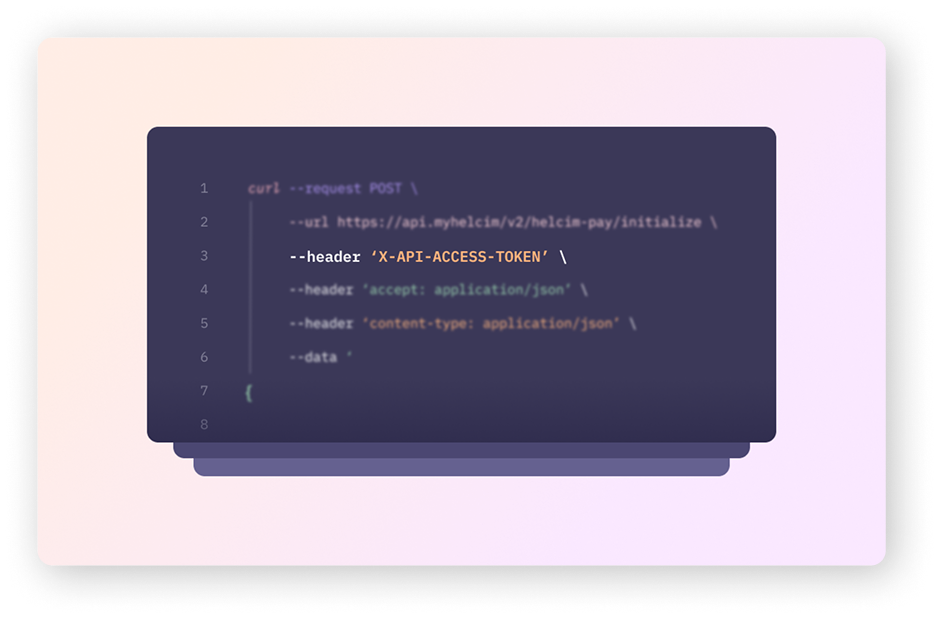The Helcim API is a powerful tool that allows different programs to interact with the Helcim platform. In simple terms, it's a way for your business's software to "talk" to Helcim's systems, enabling you to automate tasks and integrate Helcim's features into your own applications.
This article will break down how the Helcim API works, and how you can get started with using it to build custom payment solutions for your business.

In this article
What is an API?
An API (application programming interface) is essentially a contract between two pieces of software, allowing them to exchange information and perform tasks with each other.
| Imagine you're at a restaurant. You don't need to know how the chef prepares your meal, or how the waiter communicates your order to the kitchen. You simply place your order from the menu, and the food appears. |
An API works similarly. Your software sends a request for information or to perform an action, and the Helcim platform responds with the requested data or confirmation that the action was completed. You don't need to know the complex processes happening behind the scenes.
This is different from how you normally interact with Helcim through our website. When you log in to your Helcim account, you're using the web user interface (UI), which is designed for humans to see and click on things.
An API, on the other hand, is designed for programs to interact with each other.
What can you do with the Helcim API?
The Helcim API has two main use cases:
1. Process payments
You can use the API to process credit card and ACH payments through your website or application. This includes purchases, pre-authorizations, refunds, and more.
2. Interact with the Helcim platform
Beyond payments, you can also use the API to create, view, and modify data within your Helcim account. For example, you can use it to:
Create and manage invoices.
Manage customer information.
Generate reports.
Update product information.
The Helcim API is organized into several subcategories, each designed for specific functions.
API Category | Use Cases |
|---|---|
Payment API | Process credit card payments (purchases, pre-authorizations, etc.), retrieve transactions, manage batches. |
Invoice API | Create, retrieve, and update invoices. |
Customer API | Create, retrieve, and update customers, manage customer payment information. |
ACH Payment API | Process ACH bank payments. |
Smart Terminal API | Process in-person transactions via a third-party POS system connected to a Helcim Smart Terminal. |
Recurring API | Set up recurring payment plans and subscriptions. |
Who is the Helcim API for?
The Helcim API is designed for businesses that need to integrate Helcim's functionality into their own custom software. This means you'll need access to software developers who can write the code to connect to the API.
Generally, there are two main types of businesses that use APIs:
Tech-driven businesses: Companies that rely heavily on technology often use APIs to automate processes and streamline workflows. For example, if you’re an e-commerce platform, you might use the Helcim API to automatically process payments and update order information.
Larger businesses: As businesses grow, they often need to automate tasks that were previously done manually. For instance, if you’re a subscription service with thousands of customers, you might use the API to automate recurring billing.
It's important to note that most small businesses can use Helcim's merchant-facing tools, such as Online Checkout, Payment Pages, and Invoicing, without needing to use the API.
Key features and benefits
The Helcim API offers several key advantages:
Straightforward payment processing: The API makes it easy for developers to process payments with minimal code.
Seamless card-vault integration: You can securely store customer card information and use it for future transactions.
Platform control beyond payments: The API allows you to interact with various aspects of the Helcim platform, giving you greater control over your business operations.
Important considerations
Developer required: Integrating with the Helcim API requires a software developer to write the necessary code.
API token security: Your API token is like a password and should be kept secure to prevent unauthorized access to your account.
How much does the Helcim API cost to use?
Good news! Helcim doesn't charge any extra fees for using the API. You'll simply pay the same transaction fees that come with our transparent interchange plus pricing, which is designed to save you money.
Next steps
To get started with the Helcim API, we recommend checking out our connection guide in the Helcim Developer API Docs. You can also learn more about modifying or removing API access tokens.
FAQ
Do I need a developer to use the API?
Yes, you'll need a developer to write the code to integrate with the Helcim API. If you don't have access to a developer, you can use Helcim's other tools, such as Online Checkout or Payment Pages.
What programming language can a merchant use to code with our API?
You can use any programming language that can make secure web connections.
Why use the Helcim API vs. HelcimPay.js?
HelcimPay.js is our recommended tool for embedding a Helcim payment modal on your website. It simplifies the process of securely collecting payment information.
However, the Helcim API offers broader functionality, allowing you to manage other aspects of your Helcim account, such as invoices and customers. Many businesses use both HelcimPay.js and the Helcim API to meet all their integration needs.